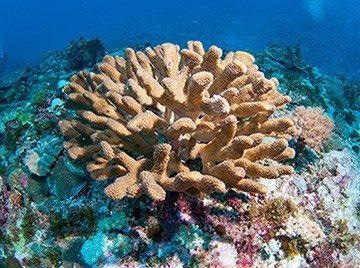Hard corals grow by producing calcium carbonate (CaCO3) from seawater and later add it to their skeletons, where it crystallizes. This process—and coral survival—are endangered by ocean acidification.
 Crystallization rates and sheltered compartments may explain why some hard corals, such as Stylophora pistillata, are more resistant to ocean acidification. Image Credit: Jung Hsuan/Shutterstock.
Crystallization rates and sheltered compartments may explain why some hard corals, such as Stylophora pistillata, are more resistant to ocean acidification. Image Credit: Jung Hsuan/Shutterstock.
Researchers in the Journal of the American Chemical Society recently reported that corals produce CaCO3 in compartments safeguarded from seawater and not, as believed earlier, in exposed locations. The observation and varying crystallization rates could describe why few species are highly resilient to this risk.
To make CaCO3, stony corals draw in calcium and carbonate ions from seawater, which is further attached to the growing skeleton in the form of amorphous particles that slowly stiffen into the less-soluble “aragonite” crystal structure.
It was believed that the particles develop and grow in a 2 μm layer of liquid on the skeleton surface called the extracellular calcifying fluid (ECF). Due to photosynthesis by symbiotic organisms present in the coral, the ECF’s pH increases in the daytime and drops again each night.
Generally, that is not a problem, but as it is partly exposed to seawater, the ECF also gets acidified to a certain degree when there is a drop in the pH level of seawater.
According to Pupa U. P. A. Gilbert and his collaborators, this phenomenon would meddle with CaCO3 formation and deposition, and kill corals that are considered to be highly sensitive to a drop in pH-level.
However, if the nucleation and growth of CaCO3 particles take place in the intracellular compartments safeguarded from seawater and the ECF—as Gilbert’s group had hypothesized in recent times. The sensitive species could also have a probability of surviving acidification, as long as the pH does not drop low. The scientists decided to resolve this question.
In coral samples, the researchers detected amorphous CaCO3 particles in a layer of cells found above the ECF. The scientists state that this finding is consistent with the growth of the particles within closed vesicles—or small sacs—inside these cells.
This implies that the formation of the particles occurs safely away from seawater and not in the ECF. But once fixed to the growing skeleton surface, they are exposed to the ECF, where they are in danger of dissolving before they crystallize.
The researchers discovered that the crystallization rates differ considerably across species. For example, the freshly added CaCO3 crystallizes more rapidly and hence remains soluble for a shorter duration, in Stylophora pistillata—a species well-known to be less vulnerable to ocean acidification.
The authors acknowledge financial support from the US Department of Energy, the US National Science Foundation, and the European Research Council.
Journal Reference:
Schmidt, C. A., et al. (2022) Faster Crystallization during Coral Skeleton Formation Correlates with Resilience to Ocean Acidification. Journal of the American Chemical Society. doi.org/10.1021/jacs.1c11434.